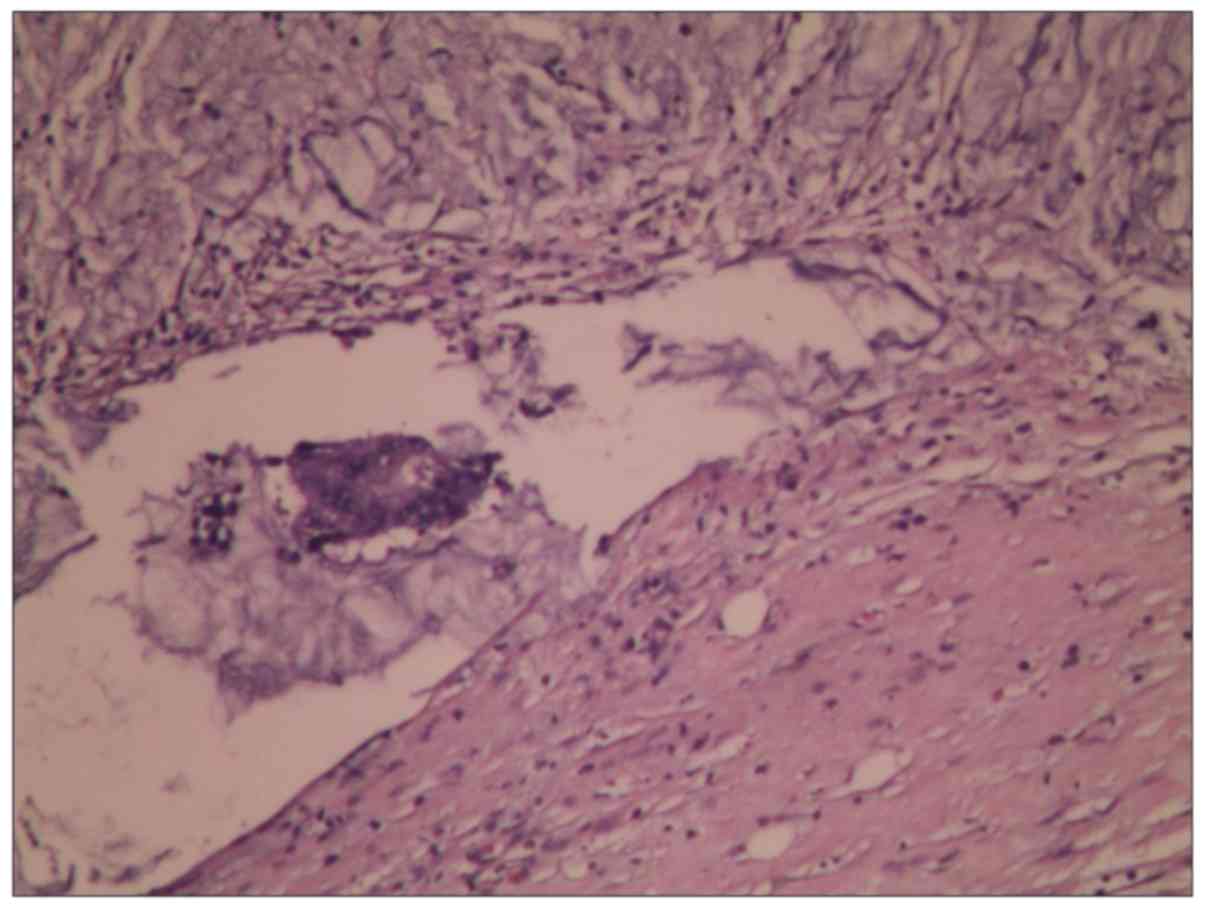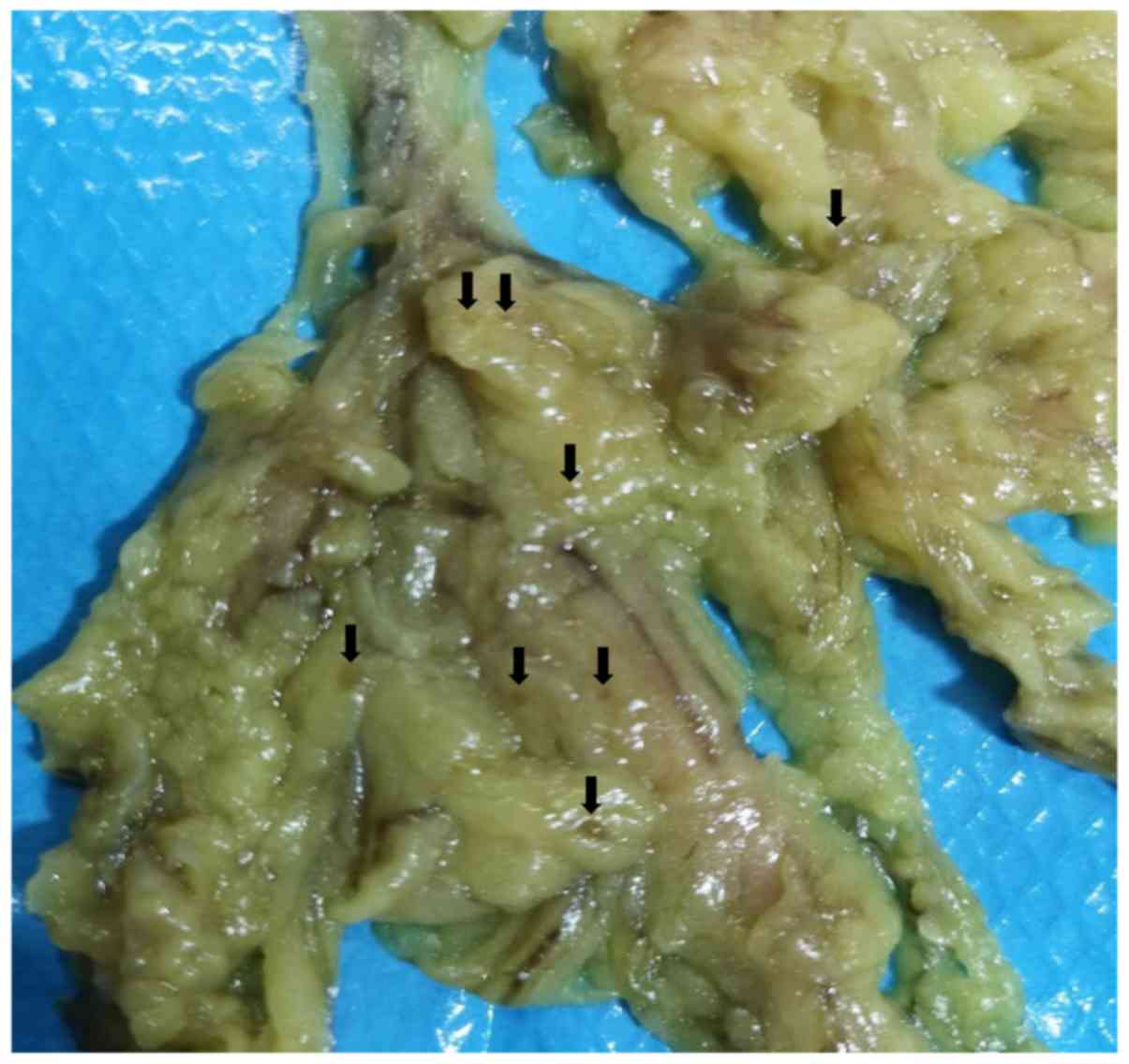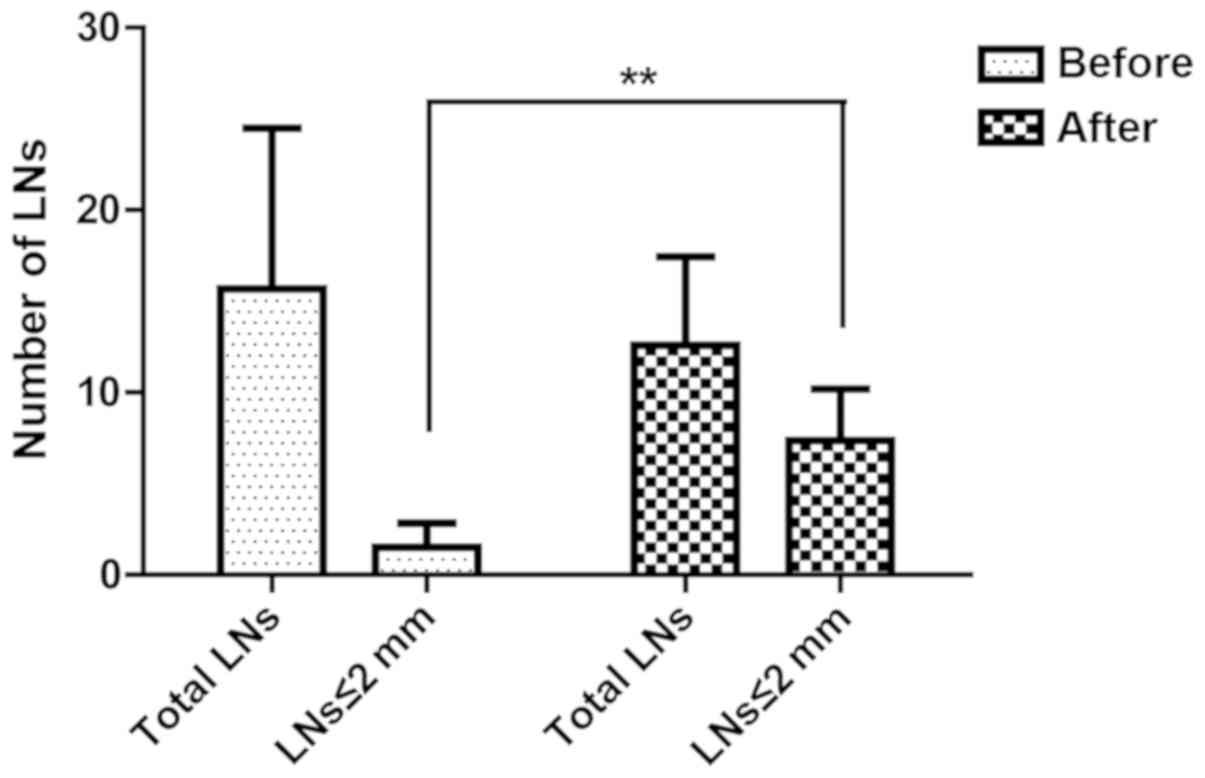|
1
|
Benson AB III, Venook AP, Cederquist L,
Chan E, Chen YJ, Cooper HS, Deming D, Engstrom PF, Enzinger PC,
Fichera A, et al: Colon cancer, version 1.2017, NCCN Clinical
Practice Guidelines in Oncology. J Natl Compr Canc Netw.
15:370–398. 2017.PubMed/NCBI View Article : Google Scholar
|
|
2
|
Murphy J, O'Sullivan GC and Fitzgibbon J:
The effect of node size on the detection of nodal metastases in
Dukes C rectal carcinoma. Gut. 44(A84)1999.
|
|
3
|
Tepper JE, O'Connell MJ, Niedzwiecki D,
Hollis D, Compton C, Benson AB III, Cummings B, Gunderson L,
Macdonald JS and Mayer RJ: Impact of number of nodes retrieved on
outcome in patients with rectal cancer. J Clin Oncol. 19:157–163.
2001.PubMed/NCBI View Article : Google Scholar
|
|
4
|
Goldstein NS, Sanford W, Coffey M and
Layfield LJ: Lymph node recovery from colorectal resection
specimens removed for adenocarcinoma. Trends over time and a
recommendation for a minimum number of lymph nodes to be recovered.
Am J Clin Pathol. 106:209–216. 1996.PubMed/NCBI View Article : Google Scholar
|
|
5
|
Kim YW, Kim NK, Min BS, Lee KY, Sohn SK
and Cho CH: The influence of the number of retrieved lymph nodes on
staging and survival in patients with stage II and III rectal
cancer undergoing tumor-specific mesorectal excision. Ann Surg.
249:965–972. 2009.PubMed/NCBI View Article : Google Scholar
|
|
6
|
Brown HG, Luckasevic TM, Medich DS,
Celebrezze JP and Jones SM: Efficacy of manual dissection of lymph
nodes in colon cancer resections. Mod Pathol. 17:402–406.
2004.PubMed/NCBI View Article : Google Scholar
|
|
7
|
Sarli L, Bader G, Iusco D, Salvemini C,
Mauro DD, Mazzeo A, Regina G and Roncoroni L: Number of lymph nodes
examined and prognosis of TNM stage II colorectal cancer. Eur J
Cancer. 41:272–279. 2005.PubMed/NCBI View Article : Google Scholar
|
|
8
|
Valsecchi ME, Leighton J Jr and Tester W:
Modifiable factors that influence colon cancer lymph node sampling
and examination. Clin Colorectal Cancer. 9:162–167. 2010.PubMed/NCBI View Article : Google Scholar
|
|
9
|
Baxter NN, Morris AM, Rothenberger DA and
Tepper JE: Impact of preoperative radiation for rectal cancer on
subsequent lymph node evaluation: A population-based analysis. Int
J Radiat Oncol Biol Phys. 61:426–431. 2005.PubMed/NCBI View Article : Google Scholar
|
|
10
|
Scott KW and Grace RH: Detection of lymph
node metastases in colorectal carcinoma before and after fat
clearance. Br J Surg. 76:1165–1167. 1989.PubMed/NCBI View Article : Google Scholar
|
|
11
|
Koren R, Siegal A, Klein B, Halpern M,
Kyzer S, Veltman V and Gal R: Lymph node-revealing solution: Simple
new method for detecting minute lymph nodes in colon carcinoma. Dis
Colon Rectum. 40:407–410. 1997.PubMed/NCBI View Article : Google Scholar
|
|
12
|
Wang H, Safar B, Wexner SD, Denoya P and
Berho M: The clinical significance of fat clearance lymph node
harvest for invasive rectal adenocarcinoma following neoadjuvant
therapy. Dis Colon Rectum. 52:1767–1773. 2009.PubMed/NCBI View Article : Google Scholar
|
|
13
|
Newell KJ, Sawka BW, Rudrick BF and Driman
DK: GEWF solution. Arch Pathol Lab Med. 125:642–645.
2001.PubMed/NCBI View Article : Google Scholar
|
|
14
|
Prabhudesai AG, Dalton R, Kumar D and
Finlayson CJ: Mechanised one-day fat clearance method to increase
the lymph node yield in rectal cancer specimens. Br J Biomed Sci.
62:120–123. 2005.PubMed/NCBI View Article : Google Scholar
|
|
15
|
Estrela C, Estrela CR, Barbin EL, Spano
JC, Marchesan MA and Pecora JD: Mechanism of action of sodium
hypochlorite. Braz Dent J. 13:113–117. 2002.PubMed/NCBI View Article : Google Scholar
|
|
16
|
Coffey JC and O'Leary DP: The mesentery:
Structure, function, and role in disease. Lancet Gastroenterol
Hepatol. 1:238–247. 2016.PubMed/NCBI View Article : Google Scholar
|
|
17
|
Tartari T, Bachmann L, Maliza AG, Andrade
FB, Duarte MA and Bramante CM: Tissue dissolution and modifications
in dentin composition by different sodium hypochlorite
concentrations. J Appl Oral Sci. 24:291–298. 2016.PubMed/NCBI View Article : Google Scholar
|
|
18
|
Herrera-Ornelas L, Justiniano J, Castillo
N, Petrelli NJ, Stulc JP and Mittelman A: Metastases in small lymph
nodes from colon cancer. Arch Surg. 122:1253–1256. 1987.PubMed/NCBI View Article : Google Scholar
|
|
19
|
Rodriguez-Bigas MA, Maamoun S, Weber TK,
Penetrante RB, Blumenson LE and Petrelli NJ: Clinical significance
of colorectal cancer: Metastases in lymph nodes <5 mm in size.
Ann Surg Oncol. 3:124–130. 1996.PubMed/NCBI View Article : Google Scholar
|
|
20
|
Haboubi NY, Abdalla SA, Amini S, Clark P,
Dougal M, Dube A and Schofield P: The novel combination of fat
clearance and immunohistochemistry improves prediction of the
outcome of patients with colorectal carcinomas: A preliminary
study. Int J Colorectal Dis. 13:99–102. 1998.PubMed/NCBI View Article : Google Scholar
|
|
21
|
Monig SP, Baldus SE, Zirbes TK, Schröder
W, Lindemann DG, Dienes HP and Hölscher AH: Lymph node size and
metastatic infiltration in colon cancer. Ann Surg Oncol. 6:579–581.
1999.PubMed/NCBI View Article : Google Scholar
|
|
22
|
Le Voyer TE, Sigurdson ER, Hanlon AL,
Mayer RJ, Macdonald JS, Catalano PJ and Haller DG: Colon cancer
survival is associated with increasing number of lymph nodes
analyzed: A secondary survey of intergroup trial INT-0089. J Clin
Oncol. 21:2912–2919. 2003.PubMed/NCBI View Article : Google Scholar
|
|
23
|
Washington MK: Colorectal carcinoma:
Selected issues in pathologic examination and staging and
determination of prognostic factors. Arch Pathol Lab Med.
132:1600–1607. 2008.PubMed/NCBI View Article : Google Scholar
|
|
24
|
Kim YM, Suh JH, Cha HJ, Jang SJ, Kim MJ,
Yoon S, Kim B, Chang H, Kwon Y, Hong EK and Ro JY: Additional lymph
node examination from entire submission of residual mesenteric
tissue in colorectal cancer specimens may not add clinical and
pathologic relevance. Hum Pathol. 38:762–767. 2007.PubMed/NCBI View Article : Google Scholar
|
|
25
|
Fujino S, Miyoshi N, Ohue M, Noura S,
Tomita Y, Yano M and Sakon M: New enhanced and effective method for
staging cancer to detect lymph nodes after fat-dissociation. Oncol
Rep. 32:922–926. 2014.PubMed/NCBI View Article : Google Scholar
|
|
26
|
Haboubi NY, Clark P, Kaftan SM and
Schofield PF: The importance of combining xylene clearance and
immunohistochemistry in the accurate staging of colorectal
carcinoma. J R Soc Med. 85:386–388. 1992.PubMed/NCBI
|
|
27
|
Compton CC, Fielding LP, Burgart LJ,
Conley B, Cooper HS, Hamilton SR, Hammond ME, Henson DE, Hutter RV,
Nagle RB, et al: Prognostic factors in colorectal cancer. College
of American pathologists consensus statement 1999. Arch Pathol Lab
Med. 124:979–994. 2000.PubMed/NCBI View Article : Google Scholar
|
|
28
|
Vogel C, Kirtil T, Oellig F and Stolte M:
Lymph node preparation in resected colorectal carcinoma specimens
employing the acetone clearing method. Pathol Res Pract. 204:11–15.
2008.PubMed/NCBI View Article : Google Scholar
|
|
29
|
Markl B, Kerwel TG, Wagner T, Anthuber M
and Arnholdt HM: Methylene blue injection into the rectal artery as
a simple method to improve lymph node harvest in rectal cancer. Mod
Pathol. 20:797–801. 2007.PubMed/NCBI View Article : Google Scholar
|
|
30
|
Moorer WR and Wesselink PR: Factors
promoting the tissue dissolving capability of sodium hypochlorite.
Int Endod J. 15:187–196. 1982.PubMed/NCBI View Article : Google Scholar
|
|
31
|
Christensen CE, McNeal SF and Eleazer P:
Effect of lowering the pH of sodium hypochlorite on dissolving
tissue in vitro. J Endod. 34:449–452. 2008.PubMed/NCBI View Article : Google Scholar
|
|
32
|
Ma XL, Ye JX, Su J, Qi FF, Meng QY and Shi
XY: A modified GEWF solution is cost-saving and effective for lymph
node retrieval in resected colorectal carcinoma specimens. Pathol
Res Pract. 210:543–547. 2014.PubMed/NCBI View Article : Google Scholar
|












